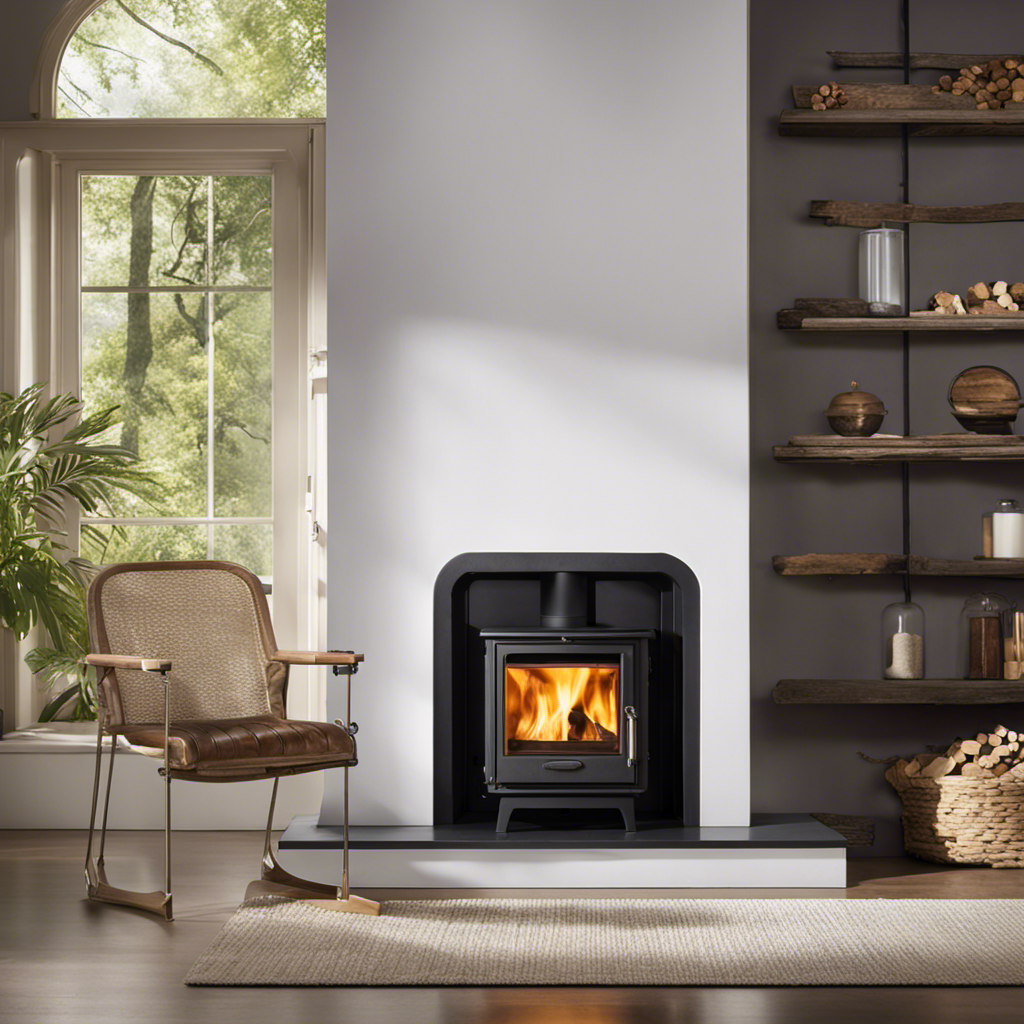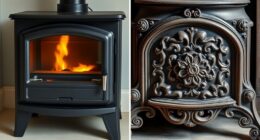
As an individual who owns a wood stove, I have encountered the puzzling issue of unusual odors coming from my stove, even when it is not being used. There appears to be a persistent smell that permeates the whole room, leaving me confused about its source.
In this article, we’ll dive deep into the possible causes of these odors, from creosote build-up to moisture and mold issues, and explore effective solutions to keep your wood stove smelling fresh and clean.
Key Takeaways
- Creosote buildup in the chimney and blockage in the chimney can cause wood stove odor when not in use.
- Proper insulation, regular chimney inspections, and controlled burning techniques can help prevent and address creosote buildup.
- Regular chimney cleaning, ensuring proper ventilation, and addressing underlying issues are important for maintaining a clean and odor-free wood stove.
- Controlling moisture levels, addressing water leaks, and ensuring proper ventilation can help prevent moisture and mold issues that can cause wood stove odor.
Possible Causes of Wood Stove Odor
I think one possible cause of the wood stove odor could be a buildup of creosote in the chimney. Creosote is a byproduct of burning wood, and over time, it can accumulate in the chimney. When the wood stove isn’t in use, the creosote can emit a strong, smoky smell. This buildup can also be a fire hazard, as creosote is highly flammable.
Another cause of the wood stove odor could be a blockage or partial blockage in the chimney. This can happen due to debris, such as leaves or animal nests, getting stuck in the chimney. When the wood stove isn’t being used, these blockages can trap smoke and odors, causing them to seep into the room.
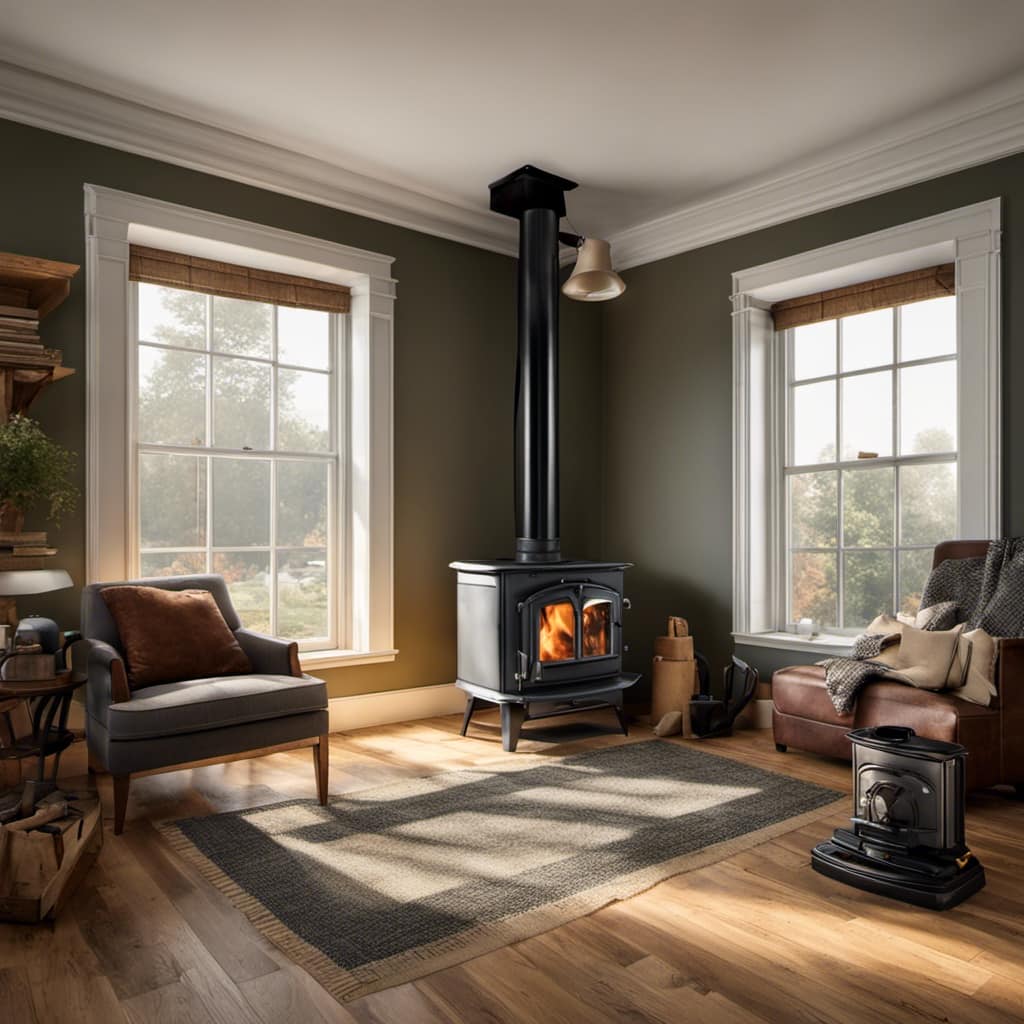
Additionally, checking the insulation around the wood stove may be necessary. If the insulation isn’t properly sealed or is damaged, it can allow smoke and odors to escape into the room. Inspecting the insulation and ensuring it’s in good condition can help prevent any unwanted smells.
Understanding Creosote Build-up
Understanding creosote build-up is crucial for maintaining the safety and efficiency of a wood stove. Creosote is a sticky, tar-like substance that forms when wood is burned incompletely.
It accumulates in the chimney and can lead to chimney fires if not regularly cleaned.
Preventing Creosote Buildup
To prevent creosote buildup in my wood stove, regular chimney cleanings are crucial. Here are three important steps I take to prevent creosote buildup and ensure the safety and efficiency of my wood stove:
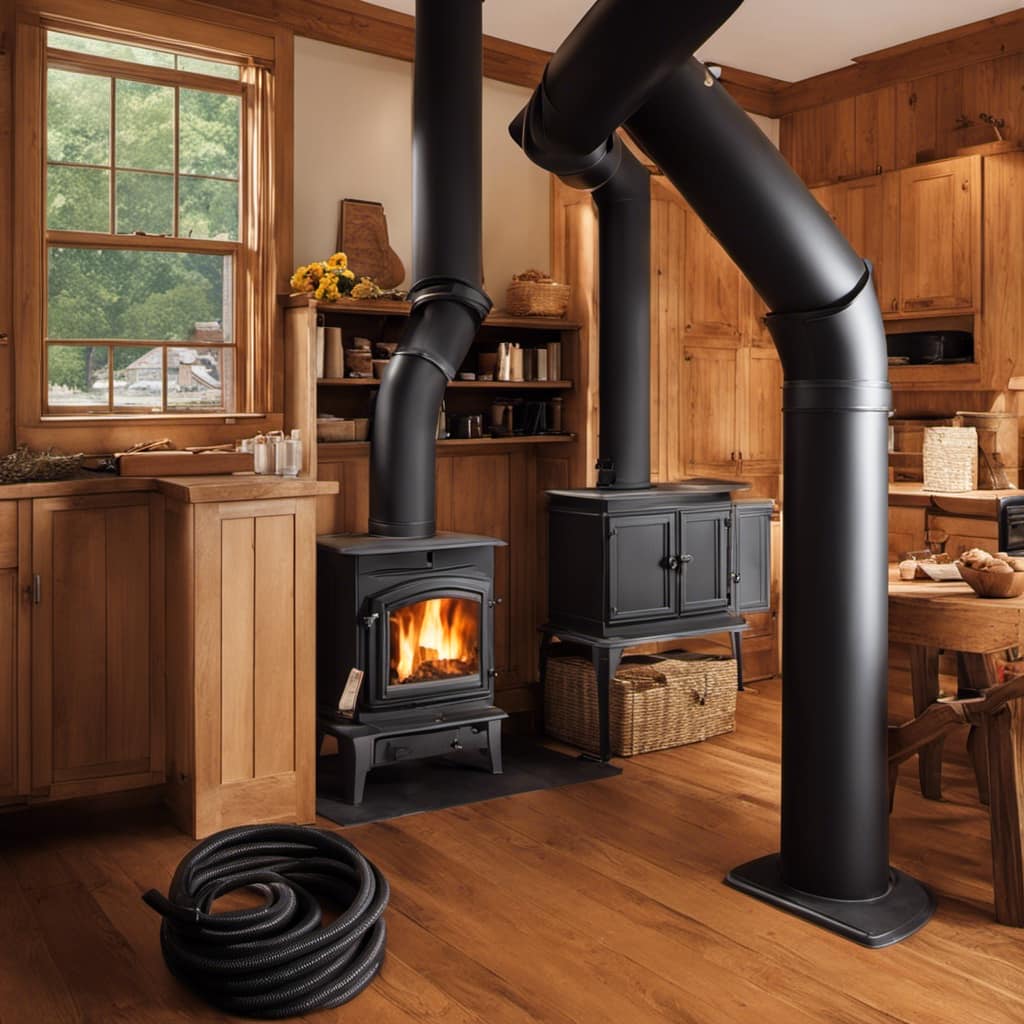
-
Proper insulation: Ensuring that my chimney is properly insulated is essential to prevent the formation of creosote. Adequate insulation helps to maintain higher temperatures inside the chimney, reducing the chance of creosote condensation.
-
Regular chimney inspections: I schedule regular inspections by a certified chimney sweep to identify any potential issues or signs of creosote buildup. They use specialized tools to remove any creosote deposits and check for any damage that may increase the risk of chimney fires.
-
Controlled burning: By practicing controlled burning techniques, such as using seasoned hardwood, avoiding overloading the stove, and maintaining a steady airflow, I can minimize the production of creosote. This helps to prevent chimney fires and keeps the wood stove operating efficiently.
Identifying Potential Causes
One potential cause of creosote buildup in my chimney is burning unseasoned firewood. When firewood isn’t properly dried or seasoned, it contains a higher moisture content. As a result, the fire doesn’t burn efficiently, leading to incomplete combustion and the release of more smoke and gases. These byproducts then travel up the chimney and condense on the cooler surfaces, forming creosote deposits.

Identifying common culprits for creosote buildup involves evaluating the type and condition of the firewood being burned. Unseasoned or green wood, which has a higher moisture content, is a primary culprit. Other factors that contribute to creosote formation include restricted airflow, improper chimney sizing, and incomplete combustion due to a poorly functioning damper or air inlet.
Cleaning Chimney Regularly
Regularly cleaning my chimney is essential to prevent the buildup of creosote and ensure the safe and efficient operation of my fireplace. Here are three key reasons why maintaining a regular cleaning schedule is crucial:
-
Cleaning frequency: Chimneys should be cleaned at least once a year to remove any accumulated soot, debris, and creosote. Creosote is a highly flammable substance that can accumulate inside the chimney and increase the risk of chimney fires.
-
Safety: A clean chimney allows for proper ventilation, reducing the chances of carbon monoxide buildup in the house. Additionally, removing any blockages or obstructions ensures that smoke and gases can escape freely, preventing any potential health hazards.
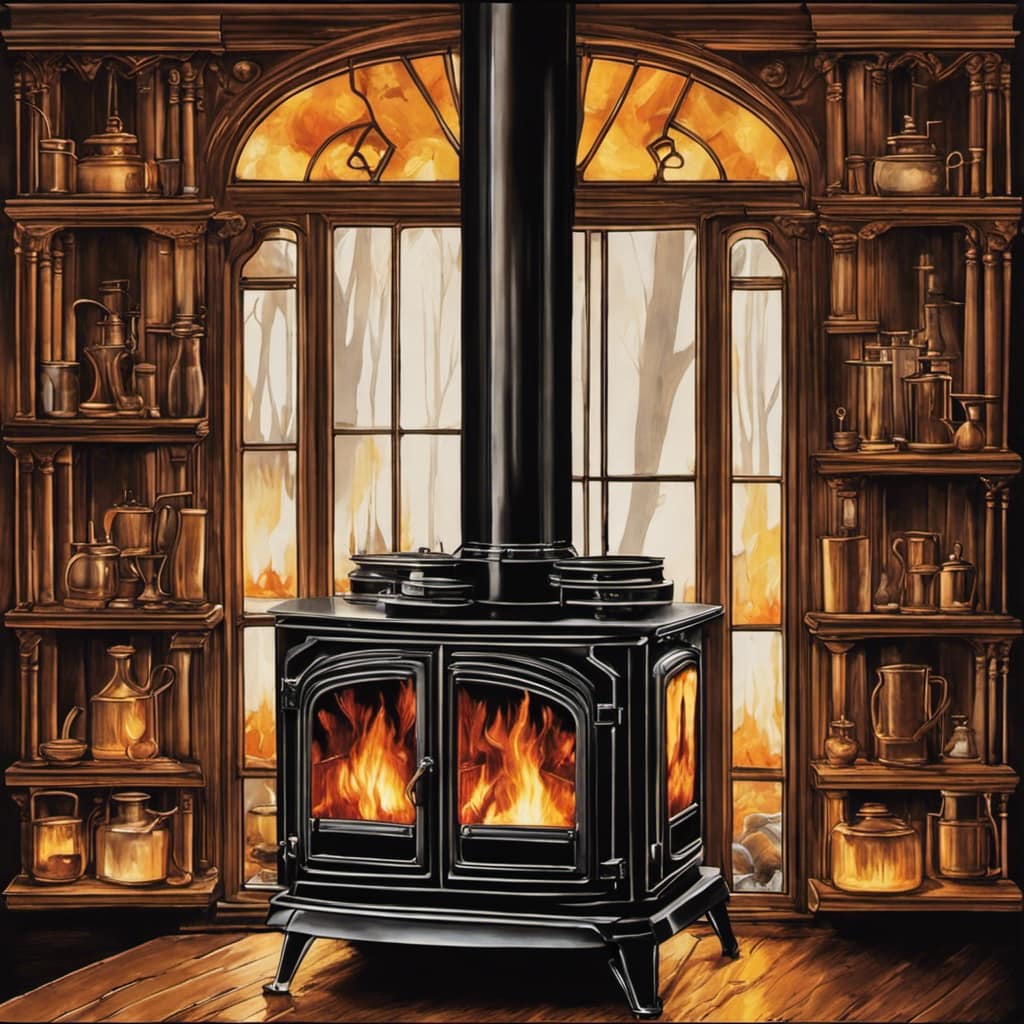
-
Professional chimney cleaning: While regular maintenance can be done by homeowners, it’s highly recommended to hire a professional chimney sweep for a thorough cleaning. Professionals have the expertise, tools, and knowledge to identify and address any underlying issues that may affect the chimney’s performance.
Dealing With Moisture and Mold Issues
As an expert in moisture and mold issues, I understand the importance of preventing mold growth and eliminating musty odors.
This can be achieved by controlling moisture levels in the environment, ensuring proper ventilation, and promptly addressing any water leaks or spills.
Preventing Mold Growth
I can prevent mold growth by ensuring proper ventilation in the area around my wood stove. Here are three key steps I take to prevent condensation and control humidity levels:

-
Install a vent hood: A vent hood helps to remove the hot air and moisture produced by the wood stove. It should be installed directly above the stove and vented outside to prevent condensation buildup.
-
Use a dehumidifier: A dehumidifier helps to reduce the overall humidity levels in the room. By maintaining humidity levels below 50%, it discourages mold growth and prevents musty smells.
-
Keep windows open: Opening windows when using the wood stove allows for fresh air circulation and helps to remove excess moisture. It also helps to regulate humidity levels and prevent condensation on surfaces.
Eliminating Musty Odors
To eliminate musty odors around my wood stove, I ensure proper ventilation and control humidity levels. This is crucial because excess moisture can lead to the growth of mold and mildew, resulting in unpleasant smells.
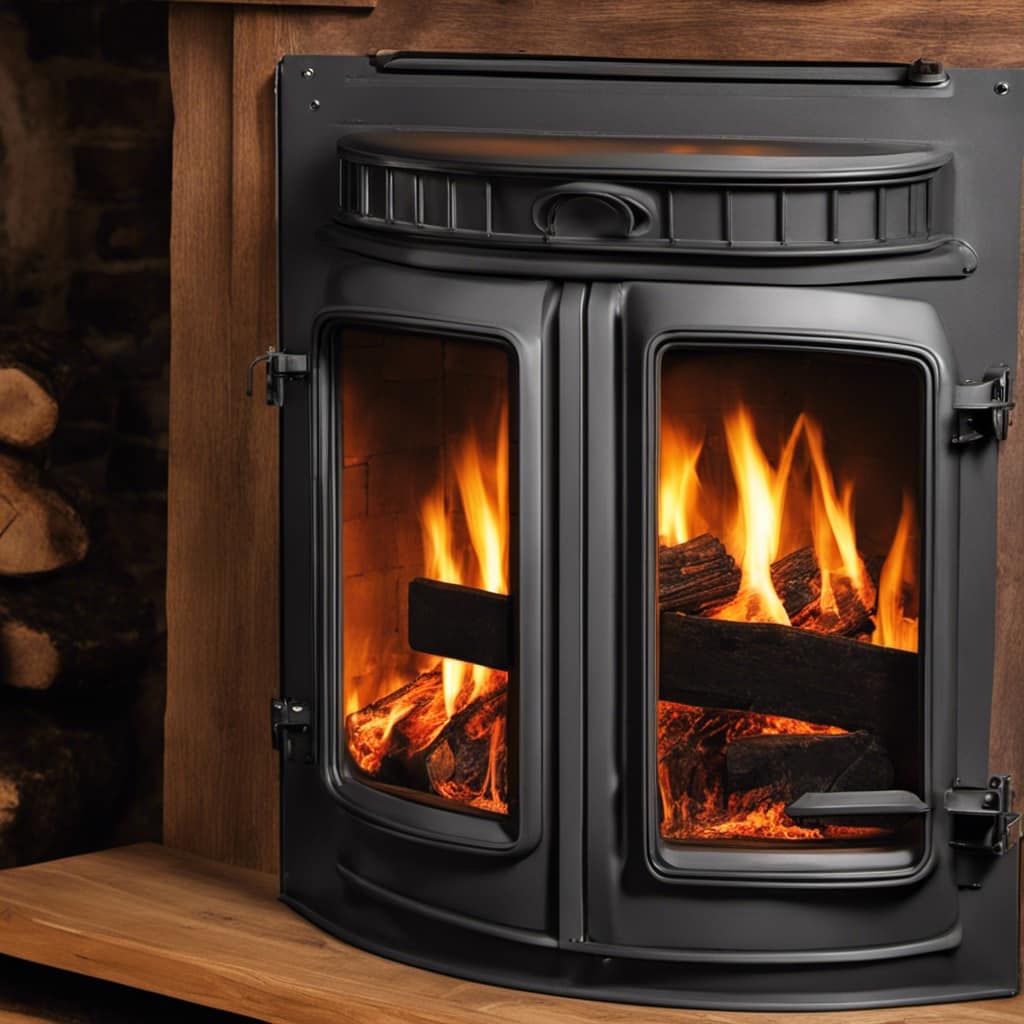
Firstly, I make sure that there’s adequate airflow by opening windows or using fans to circulate fresh air.
Additionally, I regulate the humidity levels by using a dehumidifier. There are various dehumidifier options available, ranging from portable units to whole-house systems, depending on the size of the area and the severity of the moisture issue.
Furthermore, I employ air freshener solutions to mask any remaining odors. This can be achieved through the use of natural air fresheners, such as baking soda or essential oils, or by utilizing commercial air freshener sprays or plug-in devices.
Exploring Chimney Ventilation Problems
When my wood stove isn’t in use, I can’t help but notice the lingering smell, which makes me wonder if there are any chimney ventilation problems. As a homeowner, it’s crucial to address chimney blockage and find suitable ventilation solutions to ensure the proper functioning of the wood stove.
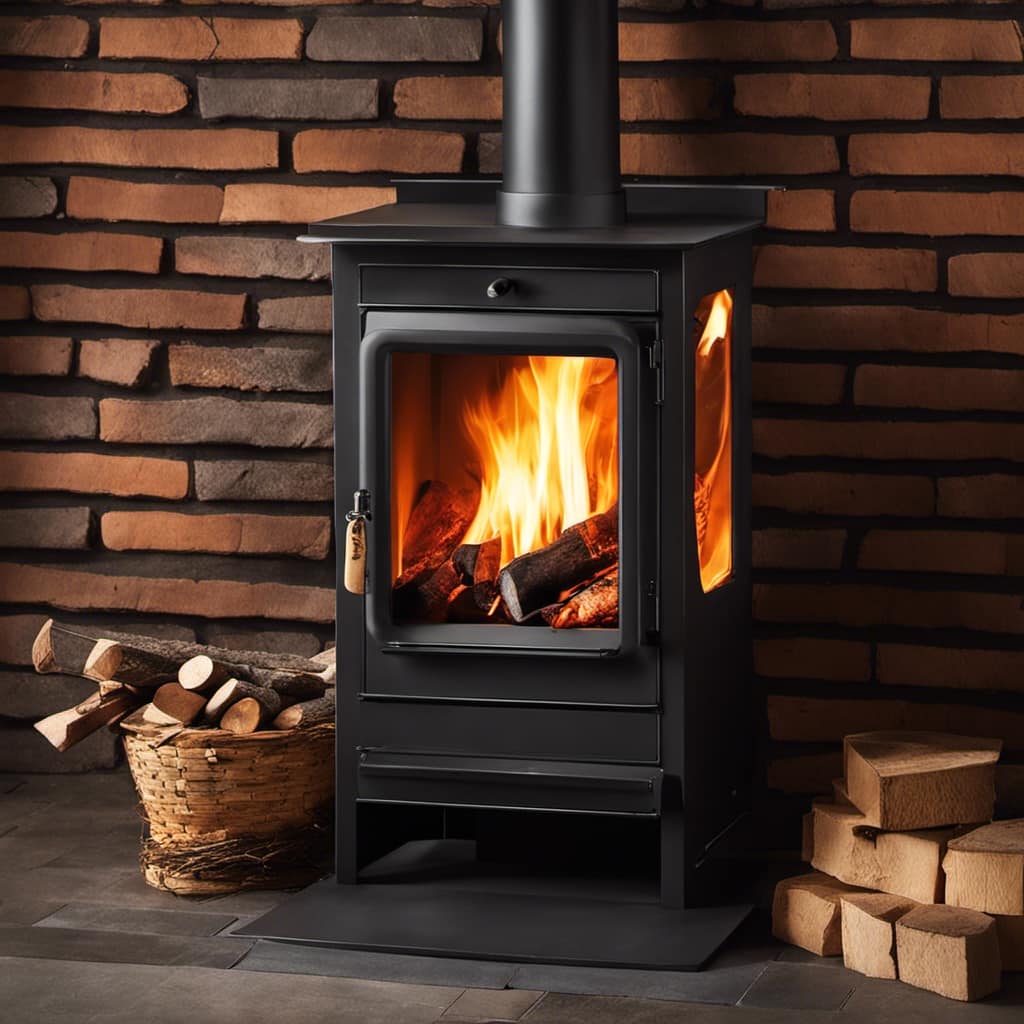
Here are three key factors to consider when exploring chimney ventilation problems:
-
Blockage: A common cause of poor chimney ventilation is blockage. Over time, creosote and soot can build up inside the chimney, obstructing the airflow. Additionally, debris such as leaves, bird nests, or even small animals can create blockages. Regular chimney cleaning and inspection can help identify and remove any obstructions.
-
Insufficient draft: Insufficient draft occurs when the chimney fails to draw in enough air to ensure proper combustion. This can be caused by a variety of factors, such as a poorly designed chimney or a chimney that’s too short. Installing a chimney cap or adjusting the chimney height can help improve draft and ventilation.
-
Damaged chimney liner: A damaged chimney liner can also impact ventilation. Cracks, gaps, or deterioration in the liner can disrupt the airflow and cause smoke to escape into the living space. Repairing or replacing the chimney liner is essential to maintain a safe and efficient wood stove operation.

Identifying Airflow Restrictions in the Stove
As a homeowner, I can easily identify airflow restrictions in my stove by checking for any obstructions or blockages in the chimney. When it comes to identifying ventilation issues and troubleshooting airflow problems, the chimney plays a crucial role in maintaining a healthy and efficient wood stove.
One of the first things I do is visually inspect the chimney from both the inside and outside. I carefully look for any signs of debris, such as leaves, nests, or other foreign objects that could potentially block the airflow. Additionally, I check for any cracks or damages in the chimney structure that could impact the ventilation.
If I notice any obstructions or blockages, I take immediate action to remove them. This can involve using a chimney sweep or specialized tools to clear out any debris. I also make sure to clean the chimney on a regular basis to prevent the buildup of creosote, which can restrict airflow and lead to poor stove performance.
Addressing Animal Intrusion and Nesting
I regularly inspect my chimney for any signs of animal intrusion or nesting, as this can lead to airflow restrictions and potential damage to my stove. Addressing animal intrusion and removing nesting is crucial to maintain the proper functioning of my wood stove.

Here’s how I ensure that my chimney remains free from any unwanted visitors:
-
Visual Inspection: I carefully examine the exterior of the chimney for any signs of animal activity such as droppings, claw marks, or nests. I pay close attention to areas where animals can easily gain access, such as loose bricks or damaged chimney caps.
-
Chimney Cap Installation: Installing a chimney cap is an effective way to prevent animals from entering the chimney. The cap acts as a barrier while still allowing proper airflow. I make sure the cap is securely attached and inspect it regularly for any damage.
-
Professional Cleaning: If I discover any signs of animal intrusion or nesting, I immediately contact a professional chimney sweep. They have the expertise and tools to safely remove any animals or nests, ensuring that my chimney is clear and ready for use.

Solving Fuel Quality and Storage Concerns
When it comes to wood stoves, ensuring the quality and proper storage of fuel is crucial for optimal performance and safety. As an expert in this field, I understand the importance of addressing fuel quality and storage concerns.
First and foremost, it’s essential to choose high-quality fuel for your wood stove. Dry and seasoned firewood is ideal, as it burns efficiently, produces less smoke, and minimizes the risk of creosote buildup in your chimney. Moisture content should be below 20% for optimal burning.
Proper fuel storage is equally vital. Storing firewood in a dry and well-ventilated area is key to maintaining its quality. It should be raised off the ground to prevent moisture absorption and allow for proper airflow. Additionally, covering the woodpile with a tarp or waterproof cover can protect it from rain or snow.
Regular inspections of your fuel storage area are essential to identify any signs of moisture or pest infestation. Any damp or insect-infested wood should be promptly removed to prevent the spread of mold or pests.

Effective Cleaning and Maintenance Practices
Regular cleaning and maintenance of my wood stove is crucial for optimal performance and to prevent any potential issues. As someone who relies on my wood stove for heating and cooking, I understand the importance of effective cleaning techniques and proper maintenance procedures.
Here are three key steps I follow to ensure my wood stove remains in top condition:
-
Clearing out ashes: After each use, I carefully remove the ashes from the firebox using a metal scoop or shovel. It’s important to wait until the ashes have completely cooled down before disposing of them in a metal container, as hot ashes can pose a fire hazard.
-
Cleaning the flue and chimney: I schedule an annual inspection and cleaning of my wood stove’s flue and chimney. This helps to remove any built-up creosote, which can cause chimney fires. A professional chimney sweep will also check for any obstructions or damage that may affect the stove’s performance.

-
Checking gaskets and seals: Regularly inspecting and replacing worn-out gaskets and seals is essential for maintaining the stove’s efficiency. These components help to create an airtight seal, ensuring proper combustion and preventing any smoke or odors from escaping into the room.
Frequently Asked Questions
How Can I Prevent Animals From Nesting in My Wood Stove When It’s Not in Use?
To prevent nesting animals in a wood stove when not in use, it’s important to ensure its cleanliness. Regularly inspect the stove for any signs of animal activity, such as droppings or nesting materials. Clean out any debris or nesting materials promptly.
Install a chimney cap or screen to prevent animals from entering the stove through the chimney. Additionally, consider sealing any gaps or openings around the stove to further discourage animals from nesting inside.
What Are Some Common Signs of Airflow Restrictions in a Wood Stove?
When it comes to wood stove airflow restrictions, there are a few common signs to look out for.

One indicator is a decrease in heating efficiency, where the stove doesn’t warm up the space as effectively.
Another clue is the presence of smoke or odors inside the house, even when the stove isn’t in use.
Troubleshooting tips include checking for blocked chimney flues or dirty air vents, which can impede proper airflow and cause these issues.
Are There Any Specific Fuel Storage Guidelines I Should Follow to Prevent Odors?
To prevent wood stove odors, it’s essential to follow specific fuel storage guidelines. Properly storing your fuel can help ensure that it remains fresh and free from any unpleasant smells.

This includes keeping your wood in a dry and well-ventilated area, away from moisture and pests.
Additionally, it’s important to use seasoned firewood, as wet or unseasoned wood can produce more smoke and odors when burned.
Can Using Low-Quality Fuel Contribute to a Smelly Wood Stove?
Using low-quality fuel in a wood stove can indeed contribute to a smelly situation. Poor-quality fuel often contains impurities and higher moisture content, which can result in incomplete combustion. This incomplete combustion produces more smoke and odor.
Additionally, using low-quality fuel can lead to a buildup of creosote in the stove and chimney, further exacerbating the smell.
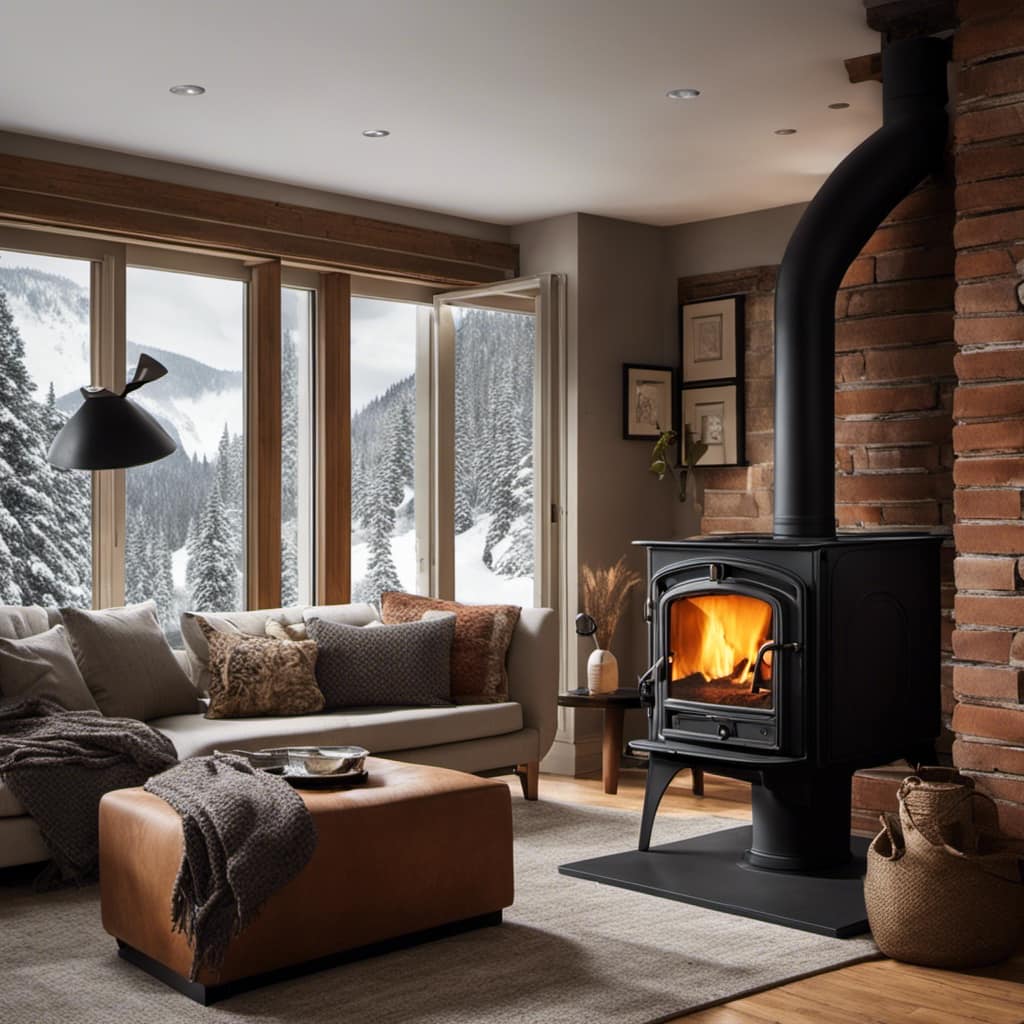
Adequate ventilation is crucial to ensure proper combustion and minimize odors caused by fuel quality issues.
Are There Any Tips for Effective Cleaning and Maintenance Practices to Eliminate Wood Stove Odors?
Ever wondered how to get rid of those pesky wood stove odors? Well, fear not, for I’ve the tips and tricks you need.
When it comes to eliminating wood stove smells, the best cleaning practices are key. Regularly clean the stove, including the flue and chimney, to remove built-up creosote and soot.
Use a high-quality wood and ensure proper airflow to prevent smoky odors.
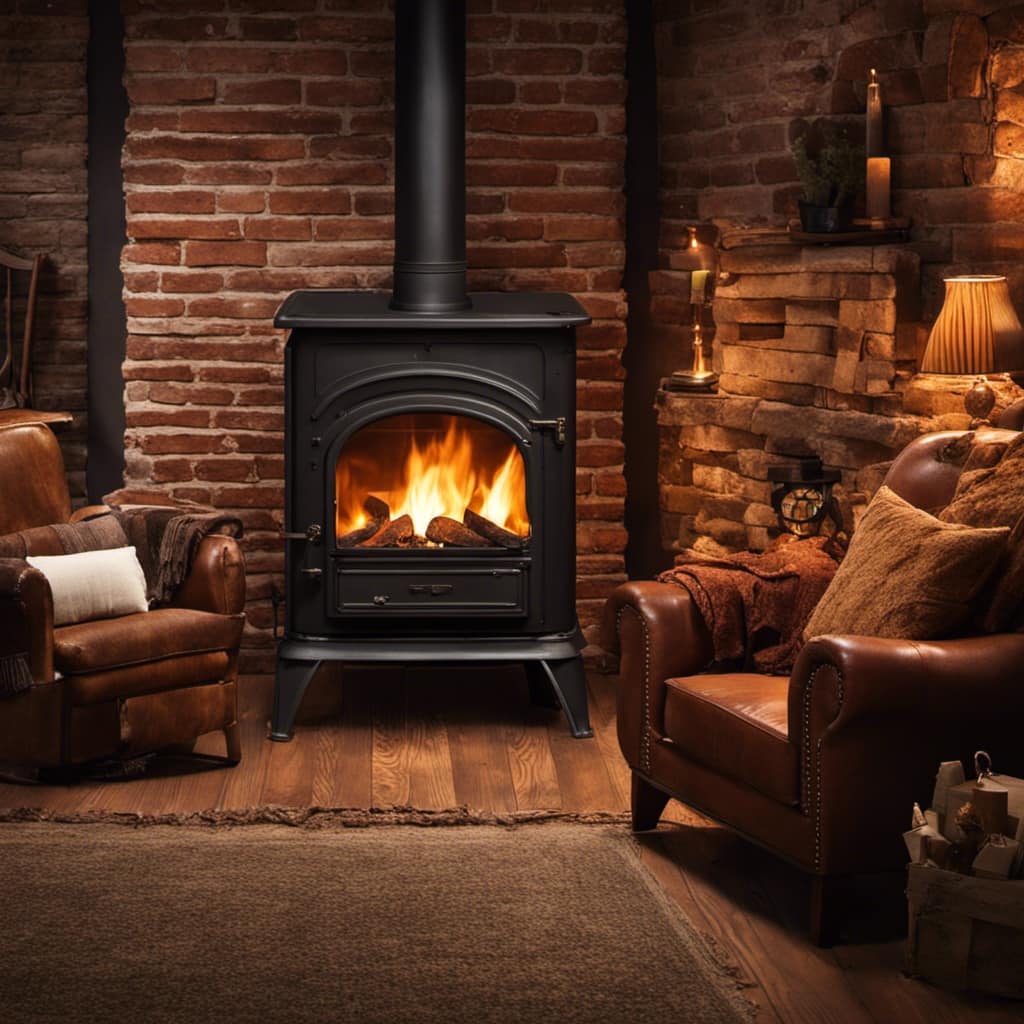
Conclusion
In conclusion, it’s essential to address the various possible causes of wood stove odor in order to ensure a clean and efficient heating system. By understanding the issues related to creosote build-up, moisture and mold, chimney ventilation, airflow restrictions, animal intrusion, fuel quality, and maintenance practices, one can effectively eliminate unpleasant smells and maintain a healthy living environment.
Remember, a well-maintained wood stove not only provides warmth but also adds a rustic charm to your home.
Growing up surrounded by the vast beauty of nature, Sierra was always drawn to the call of the wild. While others sought the comfort of the familiar, she ventured out, embracing the unpredictable and finding stories in the heartbeat of nature.
At the epicenter of every remarkable venture lies a dynamic team—a fusion of diverse talents, visions, and passions. The essence of Best Small Wood Stoves is crafted and refined by such a trio: Sierra, Logan, and Terra. Their collective expertise has transformed the platform into a leading authority on small wood stoves, radiating warmth and knowledge in equal measure.






